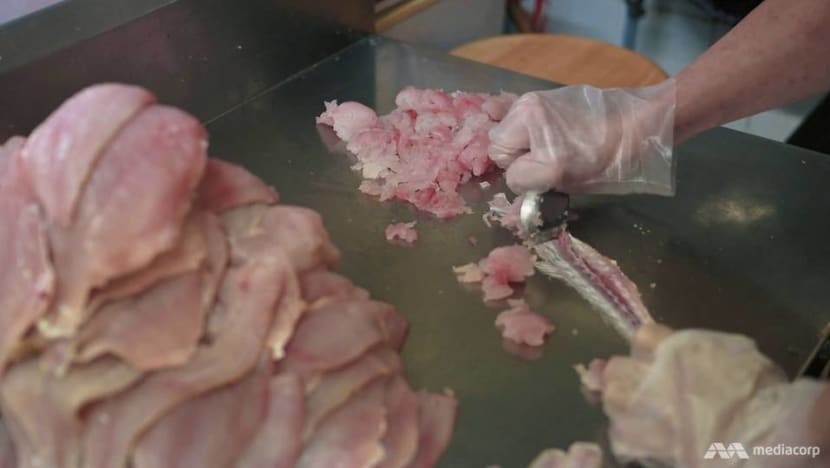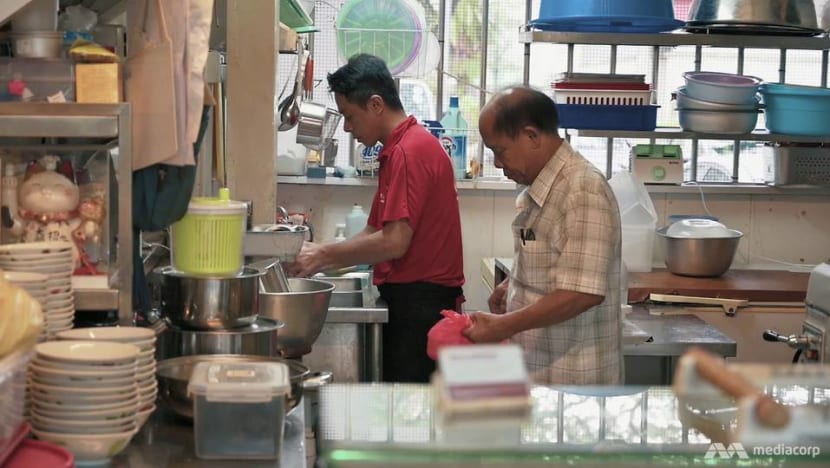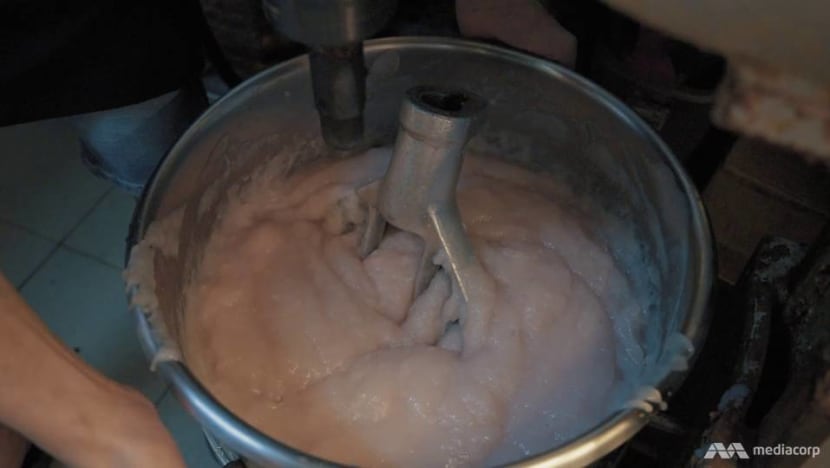Fish balls made by hand and sold out daily? Meet one of a rare breed of hawkers
Set in the traditional ways of his father, hawker Tan Chee Meng refuses to rely on machinery or pre-mixed paste to sell more fish ball noodles. But might that mean giving up the business one day?

Mr Tan Chee Meng opens his Ang Mo Kio stall at 7.30am, and usually by lunchtime, he’s out of fish balls.
SINGAPORE: After scraping and mincing the flesh of the yellow-tail fish, hawker Tan Chee Meng grabs a fistful of it, massaging gently.
As he squeezes the mixture between his thumb and index finger, he uses a spoon to form it into a ball, which is then dropped into a simmering pot of water. This process is tedious, time-consuming, and some say inefficient.
But it pays off. By 1pm, his Hup Kee fish ball noodles would be sold out.
Despite the roaring business, and the prospect of more sales by using pre-mixed fish paste or embracing automation, he insists on sticking to the traditional methods.

“We’ve persisted for so long already. If we aren’t able to scrape the fish meat, we’d find other ways till we’re no longer able to do so,” he said.
“We won’t consider fish paste … We’d (rather) give up on the business.”
This hawker from Malaysia, who operates a fish ball noodle stall in an Ang Mo Kio coffee shop, is one of very few hawkers in Singapore who still make their unevenly-shaped fish balls from scratch. And he’s proud of it.
READ: From a kampung shed, how a family fishball empire was built on automation
STEPPING IN AFTER HIS MUM’S DEATH
The 38-year-old owes his skills to his father Tan Ah Chong, who started making fish balls in Pahang in the 1980s with his wife.
Business was good, but his wife fell sick and subsequently died, leaving him devastated and unmotivated to continue with the trade.
So the younger Mr Tan stepped in, after completing his studies, to help his father. And he has been doing this for 20 years now.

He started off doing the “dirty” work: Descaling the yellow-tail fish (commonly used for making fish balls), removing the head and filleting the flesh. He also had to observe closely how his father made the fish balls.
“This isn’t a skill that you can easily catch on to,” he said. “It takes time to accumulate experience. After some time, you’d understand the process.”
Scraping the fish requires a good measure of experience; the bones are located along the middle, so one must be careful and not apply too much pressure there.
And one must scrape from the tail towards the head, to avoid getting fish bones into the flesh.

There is no big secret to their recipe, quipped the younger Mr Tan – just some salt, pepper and water, as far as they would let on. And mixing the yellow-tail fish with flour or other fish is a no-no.
“It’s purely fish meat inside the fish balls,” affirmed his father. On the choice of yellow-tail fish, the 68-year-old said its flesh has plenty of texture and that “fish balls made of this are tenderer”.
“The quality is very good. It’s good for the body too, and satisfying,” he added. “Every day, we have to finish selling the fish balls, to keep them fresh … But we often don’t have enough to sell.”
By scraping the fish themselves, they can control the texture and the taste, they said, insisting that their loyal customers would be able to tell the difference between a handmade fish ball and a factory-made one.

MACHINERY A MISTAKE, COMING TO S’PORE WASN’T
At one point, the family did invest in machinery to churn out more fish balls. But that turned out to be a mistake, said the elder Mr Tan.
“We didn’t sell the machine-made fish balls because even after many attempts, they were horribly made,” he said, adding that the look and texture of the fish balls ended up like tofu.
Or as his son put it, “They weren’t fit for consumption.”

The father had visited a fish ball factory before, and knew how fast automation could be. But the machine he bought was left unused ever since they found it ineffective.
“It’s very fast … but we aren’t taking up the challenge. No way,” he said. “For our production, it has to be done this way … Business would be good (but) it’s whether the taste is acceptable or not?”
About two years ago, the younger Mr Tan and his brother decided to venture into Singapore to try their luck. Business was slow in the first year, and they had to put in long hours.
But over time, they built up a customer base with their handmade fish ball noodles. His day now starts at 6.30am, when he leaves home to prepare the food and open the stall at 7.30am.

Their work is not done when they are sold out, however: They would make fish balls until about 9pm for the next day.
“Every fish needs to be personally scraped by me. It can’t be rushed,” he said. “Thus, making fish balls takes very long hours.”
Customers who turn up at his stall often ask, “Hai you ma (Still have any to sell)?”
Those who are turned away may complain that he makes too few fish balls, but he would explain that since it is labour-intensive, production is limited. He would then point them to another fish ball noodle stall nearby.

“When there are many customers, and we end up being sold out early, there’s no choice. We can’t produce our stuff on the spot,” he told CNA Insider, estimating that he makes up to 500 fish balls and 70 fish cakes on weekdays – and more at the weekend.
He has engaged a helper to ease his load by, for example, slicing shallots, chilli and dried bean curd. But she does not touch the fish balls.
DISAPPEARING CRAFT
Many yong tau foo or fish ball noodle stalls may claim that their products are handmade but are referring only to the shaping process.
In many cases, they buy ready-made paste from the factories and shape it at their stalls, hence fish balls from different stalls end up tasting the same.

But with people today focused on fast production output for “high returns”, the older Mr Tan understands why more are using fish paste – and rendering the art of handmade fish balls a disappearing one.
“Youngsters aren’t learning this manual work because it’s too slow and low in production,” he said. “All are not learning. And the older ones have no energy to continue. This will disappear.”
While several individuals have approached his family, looking for a partnership, he said production quantity was still a handicap.
“But it (the quantity) is really limited. We can’t cope already with one stall, why bother opening a second? Hence we didn’t proceed to think about it,” he explained.

Both father and son acknowledged that without technology to increase production, they will not make it big. And they seemed content with that.
“In a way, we aren’t able to make a lot of money. It seems good business … but you can’t have both,” said the older Mr Tan.
“You need to ensure quality standards and … produce large quantities. I’m not sure how to handle this. Thus, it’s about having a clear conscience, doing one’s best in what one does.”
Read about the family business that went from a kampung shed to a fish ball empire, built on automation.
















